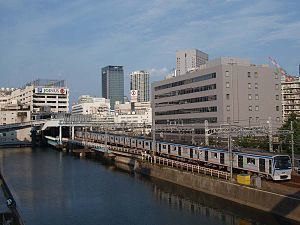Native name 相鉄本線 Termini Yokohama
Ebina Depot(s) Kashiwadai Owner Sagami Railway Stations 18 | Type Commuter rail Daily ridership 566,657 (FY2010) Line length 24.6 km (15.3 mi) Locale Kanagawa Prefecture | |
 | ||
The Sagami Railway Main Line (相鉄本線, Sōtetsu Honsen), also known as the Sōtetsu line, is a railway line in Kanagawa Prefecture, Japan, operated by the private railway operator Sagami Railway (Sōtetsu). It connects Yokohama and Ebina.
Contents
Services
In addition to all-stations "Local" services, Sotetsu operates limited-stop "Rapid" (快速, Kaisoku), "Express" (急行, Kyūkō), and "Limited Express" (特急, Tokkyū) services.
Local trains are split into 3 services: Yokohama to Futamatagawa, Futamatagawa to Ebina, and Futamatagawa along the Izumino Line to Shōnandai.
A link is under construction from Nishiya Station to a new station at Hazawa on the JR Freight Tokaido Line, enabling through services to and from the Tokaido Line. Completion is scheduled for March 2015. A further approximately 10 km extension is also planned from Hazawa to Shin-Yokohama and Hiyoshi on the Tōkyū Tōyoko Line to allow through services to and from Shibuya in Tokyo from March 2019.
Stations
Rolling stock
Non-revenue-earning stock
History
The line opened 12 May 1926 as the steam-operated Jinchu Railway (神中鉄道, Jinchū Tetsudō) between Futamatagawa and Atsugi (on the present-day Sagami Line). The line was extended from Futamatagawa to Yokohama in December 1933, and from the former station at Sagami-Kokubu (相模国分) (now closed) in November 1941.
The line became the Sagami Railway Jinchu Line (相模鉄道神中線) from 1 April 1943.
Work to electrify the line commenced in June 1942, with the entire line between Yokohama and Ebina electrified by 20 September 1944.
Work to double-track the line commenced in January 1957 between Yokohama and Nishi-Yokohama. The entire line was double-tracked by March 1974.
The first air-conditioned trains (4-car 6000 series EMUs) were introduced on the line on 3 July 1971.
10-car trains started operating on the line from 6 April 1981.
Station ticket barriers were modified to allow use of the Passnet magnetic farecard from 1 October 2000.
